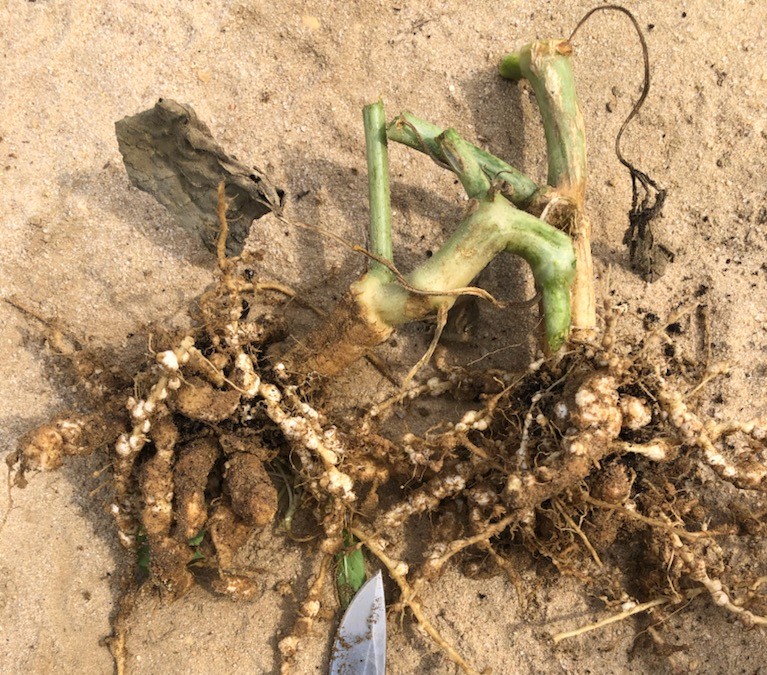The Root Knot Nematode does show up from time to time in vegetable production in New Jersey. Fortunately, for New Jersey, the distribution and damage done by the Root Knot Nematode is no where near the levels seen in regions further south of the state. There are two species involved, the Northern Root Rot Nematode (Meloidogyne hapla) and the Southern Root Rot Nematode (Meloidogyne incognito) and both species have been found in the state. Both species have broad host ranges including pepper, tomato, beet, carrot, pumpkin, cantaloupe and many other hosts, including many weeds such as pigweed, lambsquarter, and nightshade. Both species of Root Knot Nematode are migratory as juvenile worms and sedentary as adults where they feed from the outside of roots where the female develops and ultimately forming the symptomatic “knots”. This interferes with normal water and nutrient uptake as well as provides infection points for other soil-borne pathogens. Infected plants will remain stunted and chlorotic as other nearby uninfected plants appear healthy. A single mature female may lay hundreds of eggs causing drastic increases in the population with a single life cycle lasting three to four weeks to months depending on the environment. Heavily infested soils may appear as ‘hot’ spots in the field that will gradually increase in size as populations increases over time or from season to season.

Root Knot Nematode infecting cucurbit roots. Note the extensive “galling” on the roots.
Mitigating losses to Root Root Nematodes first involves the scouting for, detection and diagnosing the nematodes involved. There are other species of nematodes that infest and cause damage in vegetable crops. Scout fields for stunted plants in areas that appear as ‘hot’ spots. Simply pulling up stunted chlorotic plants and examining the root systems for the “root knots” will provide a quick diagnosis. Suspect plants should be sent to a local diagnostic lab for correct identification. Importantly, once soil becomes infested the nematodes can easily be spread to other areas of the field during cultivation or be carried around on equipment. Scouting and mapping out those areas that are infested should be noted and saved for future reference. Nematode populations, like soil-borne pathogens, will fluctuate over any given season and between seasons, thus regular scouting and testing are recommended for any field that is infested.
Proper control begins with knowing where the nematode populations are present so preventative actions can be taken, especially if susceptible crops are going to be planted. Choosing crops that are non-hosts are highly recommended. Importantly, hosts such as many commercial tomato varieties, which are Root Knot Nematode resistant, are still capable of heavy infestation, but are simply able to withstand heavy infection without suffering from extensive yield losses.
Chemical controls should be done proactively and preventatively. Please see the 2022/2023 Mid-Atlantic Commercial Vegetable Production Recommendations Guide for specific nematicide uses and recommendations for individual crops and Section E.1.5 starting on page 100 for more information on nematicides and nematode management strategies.
Other Resources:
Root Knot Nematodes in Vegetable Production – UMASS
https://ag.umass.edu/vegetable/fact-sheets/root-knot-nematode
Root Knot Nematodes in Vegetable Production – University of Maryland
https://extension.umd.edu/resource/root-knot-nematodes-vegetables
Below is a nice Extension publication of important nematodes and their host and non-host range from GA.
Click to access Plant-Susceptibility-to-Nematodes-in-Georgia.pdf

